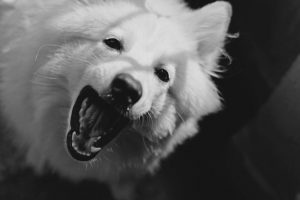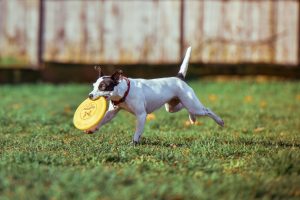 A destructive dog is something many dog owners have experienced at one point or another. Dogs who bark or howl excessively, chew things that don’t belong to them or have frequent accidents inside the house can frustrate any pet parent. Though it may seem like your dog is purposely misbehaving, these symptoms are actually often due to intense anxiety. Separation anxiety in dogs often expresses itself as a combination of these types of symptoms displayed when their owners leave them alone. A dog becomes distressed, and these destructive, messy behaviors are how that anxiety manifests.
A destructive dog is something many dog owners have experienced at one point or another. Dogs who bark or howl excessively, chew things that don’t belong to them or have frequent accidents inside the house can frustrate any pet parent. Though it may seem like your dog is purposely misbehaving, these symptoms are actually often due to intense anxiety. Separation anxiety in dogs often expresses itself as a combination of these types of symptoms displayed when their owners leave them alone. A dog becomes distressed, and these destructive, messy behaviors are how that anxiety manifests.
So how do you know if your dog is suffering from separation anxiety or something else? There’s a few questions you can ask yourself about your dog’s behavior to help narrow it down:
- Are the destructive behaviors isolated to times when the dog is alone?
- Does the dog start to exhibit anxious behaviors shortly before you leave?
- Is the dog exceptionally excited every time that you return home, even if you were only gone for a short time?
If each of these is consistently true each and every time the dog is isolated, it’s likely that they are suffering from a degree of separation anxiety.
Symptoms of Separation Anxiety in Dogs
A dog who is experiencing significant distress when they are alone will often display a number of these symptoms.
 Barking, Howling and Whining
Barking, Howling and Whining
First and foremost, an anxious dog will often express their displeasure vocally. Though many dogs may do this initially once their beloved guardian has left, excessive long-lasting barking, howling or whining can be cause for concern.
Destruction such as Chewing and Digging
Some dogs, especially puppies, can chew or dig at things in the home that they aren’t supposed to simply because they are bored. However, if you frequently come home to scratch marks on door frames or ripped up pillows, your dog may be using this to express his anxiety. It’s important to note that a dog who is dealing with separation anxiety will typically only engage in these behaviors when they’re alone. If they also get mischievous when you’re with them, it may be more of an issue of training or boredom.
Accidents in the House
The smelliest and messiest symptom of separation anxiety in dogs! Even the most well trained pup can urinate or defecate in the house when they are upset. Please note that this alone can also be a symptom of many other troubles, so if your dog is having frequent accidents it may also be worth a trip to the vet to clear him or her of any medical issues.
Intense Pacing and Restlessness
Though this one may be hard to nail down since you’re not in the dog’s presence, if you notice raw little paws and pace marks in your rugs, your dog may be pacing while you’re gone. An anxious dog is a restless one!
Attempts to Escape
This is a dangerous symptom, but a very telling one. Anxious dogs can sometimes injure themselves trying to escape through gates, doors and windows. If your dog is suffering from separation anxiety, make sure they are safely secured and loose objects that could fall and injure them are removed from typical entrance and exit routes.
It’s important to note that many of these symptoms on their own could be linked to a number of other issues, including something as simple as an untrained or bored dog! Separation anxiety in dogs often manifests as multiple, consistent symptoms that only occur when the dog is isolated.
Treatment and Prevention
The first step in treatment for separation anxiety in dogs is understanding. Be patient with your pup, and remember that his frustrating antics are due to being in intense distress, not any desire to cause trouble. Treating his or her anxiety can be time consuming, but is well worth it for both of you. There’s a number of things that you can do, and a combination of the options below will often yield the best results.
 Exercise
Exercise
Mental and physical exercise is very important for any dog. Before you leave, consider tiring out your pup with a brisk walk or some training.
Keep them busy
Though it’s common for anxious dogs to avoid food, it’s worth trying to give them something to focus on shortly before you leave. If your dog is food motivated, try a puzzle ball filled with food or treats that takes them time to release, or a Kong-like toy stuffed with peanut butter.
Leave and return calmly
Try not to make a big deal out of leaving and returning. Though your dog may be jumping for joy when you return, calmly greet them and give them some time to relax before you engage with them otherwise.
Start small
Spend some time taking small trips out of the house so they get used to you coming back. This may even involve stepping outside for 5 minutes at first, then slowly increase the time from there.
Retrain cues
If your dog starts to get anxious as soon as he or she sees you performing certain actions before you leave, such as putting on shoes or picking up the keys, then change up your routine. Pick up your keys, and then go sit on the couch. Put on your sneakers, and then do some things around the house. You can couple this with giving them something positive, like a treat or their favorite toy, to show them these cues don’t have to be a bad thing.
Give them a safe space
If your dog is crate trained, putting them in their crate when you’re away may actually give them comfort. You could also try putting them in a room with their favorite toys and fresh food and water to make them feel more secure instead of having free reign of the house. This also gives you the benefit of puppy-proofing the room for less surprises when you return.
Give the familiar smells
Try leaving your dog with something that smells like you, such as recently worn clothing, to help keep them calm.
Try calming aids
There are many calming aids for dogs on the market. Talk to your vet about medicine to help your dog relax while your gone. Or visit your local pet store for a variety of calming sprays, chews and vests to help ease their frayed nerves.
Establish a familiar phrase
Start working on a phrase that you say to your dog before you leave that they can recognize as a sign that you’ll return soon, such as “I’ll be back soon”. Though it may take some time, your dog may come to take that phrase as a comfort.
Try doggy daycare
It’s important to work in addressing the anxiety in your dog. However, there may be times where you need to be out of the house for an extended period and you don’t yet feel comfortable leaving your pup alone. Considering checking out your local doggy daycare, or have friends or neighbors come check on him or her while your gone. This may be beneficial in the beginning to help your dog get used to having you away, while still having someone keeping your pup out of trouble.
Separation anxiety in dogs can be upsetting for both of you, but with time and patience you’ll find that it is something that can be fixed. If you find that your dogs’ case of anxiety is exceptionally intense or you otherwise don’t have luck with the steps above, you can also try talking to your vet or a professional dog trainer. Your vet can help you ensure there’s no underlying medical issues contributing to your dog’s anxiety. A dog trainer can help you learn to understand your dogs behaviors better and develop a treatment plan catered more specifically to your pup’s personality and situation.
